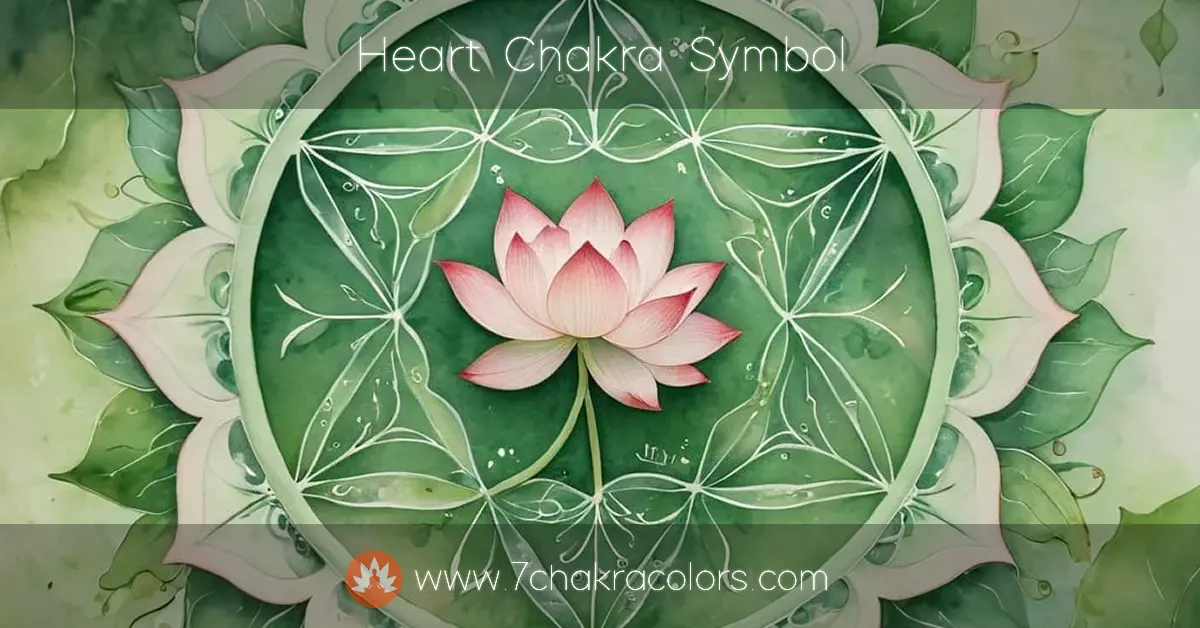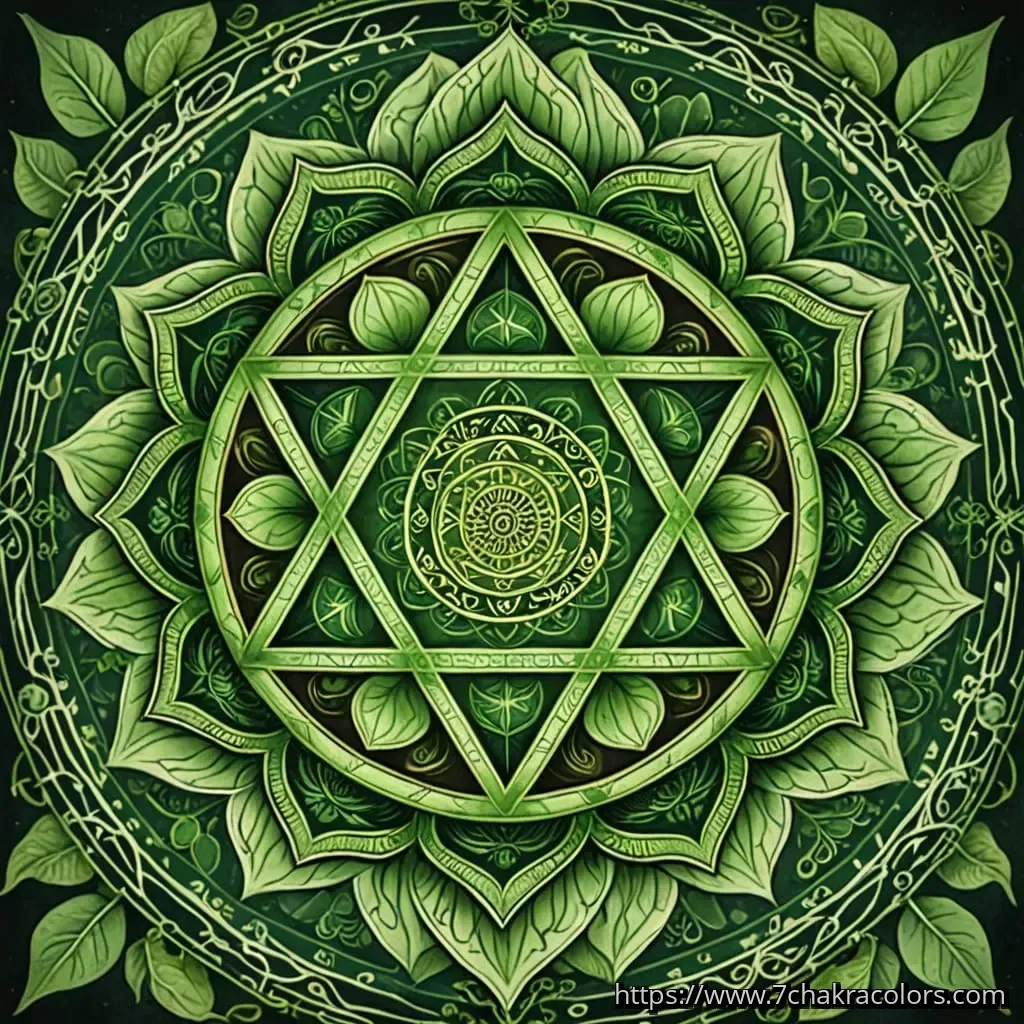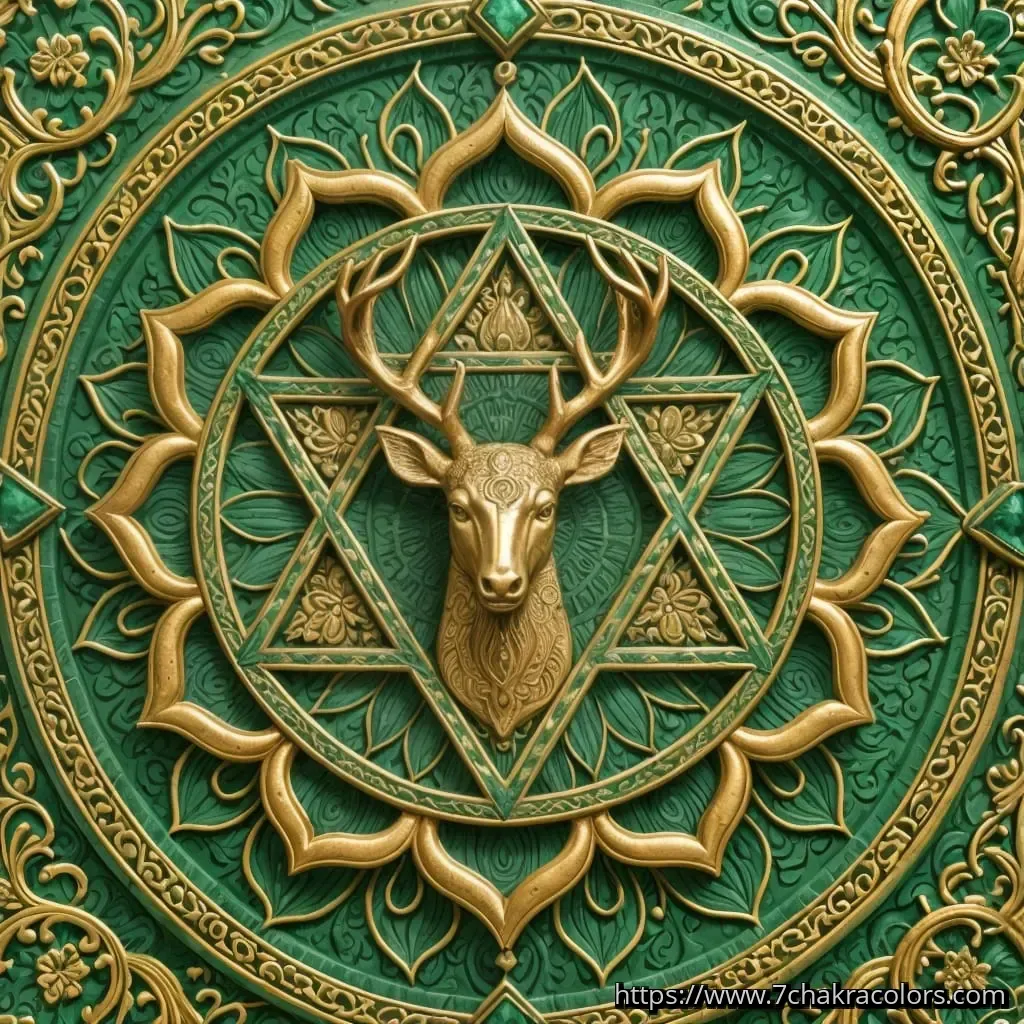

Experience the Heart Chakra Symbol’s sacred geometry and spiritual significance. Discover tattoo meanings, mantras, and healing practices for unconditional love and compassion.
The Heart Chakra symbol, also known as the Anahata symbol, consists of two intersecting triangles forming a six-pointed star (hexagram) surrounded by twelve green lotus petals. This ancient symbol carries profound significance in yoga and meditation practices. The hexagram represents the union of opposing forces—upward and downward triangles merging to create harmony and balance. In sacred geometry, this six-pointed star symbolizes the perfect integration of masculine and feminine energies, of spirit and matter.
The twelve lotus petals surrounding the star represent the twelve qualities of the heart: love, compassion, empathy, forgiveness, patience, devotion, understanding, harmony, peace, clarity, purity, and joy. At the center of the symbol lies the Sanskrit letter "यं" (YAM), the seed sound or bija mantra that activates this chakra energetically.
The root, sacral, solar plexus, heart, throat, third eye, and crown chakras each have unique symbolic representations. Dive deeper into chakra symbolism to enhance your spiritual journey.
In Hindu tradition, the Heart Chakra is associated with Vayu (or Pavana), the god of air and wind, as well as with Vishnu, the preserver deity. This connection highlights the chakra's role in maintaining balance, sustaining life energy, and nurturing compassionate connections.
The Anahata chakra appears in traditional Tantric texts dating back to the 7th and 8th centuries, where it was described as the meeting point between the lower three chakras (physical) and the upper three chakras (spiritual). In Buddhist traditions, particularly in Tibetan practices, this chakra is associated with unconditional compassion (karuna) and loving-kindness (metta).
The Sanskrit name "Anahata" translates to "unstruck" or "unhurt," referring to the mystical sound that exists without the striking of two objects together. This represents the spiritual sound of the cosmos and the pure vibration of universal love that transcends physical limitations.



The Heart Chakra symbol has become a deeply meaningful tattoo design, symbolizing love, compassion, and inner harmony. People often choose this symbol as a permanent reminder of their capacity for love and the importance of connecting with others through the heart.
Common placements for a Heart Chakra symbol tattoo include:
When considering a Heart Chakra symbol tattoo, you might opt for:
Remember that tattoos carry energetic significance, and placing the Heart Chakra symbol on your body can serve as a continuous reminder of the importance of leading with love and compassion.
For those looking to incorporate the Heart Chakra symbol into their meditation practice without a permanent tattoo, there are many options available:
These resources make it easy to incorporate the Heart Chakra symbol into your daily life, whether through digital wallpapers, printed meditation cards, or custom altar decorations.
The Heart Chakra symbol contains precise geometric forms that carry profound energetic significance. The hexagram formed by two intersecting triangles represents perfect balance and harmony—qualities essential to this fourth chakra. In sacred geometry, the hexagram is one of the most powerful symbols, representing the union of opposites and the balance of elemental forces.
The upward-pointing triangle symbolizes consciousness moving toward spiritual realms, while the downward-pointing triangle represents manifestation in the physical world. Their integration forms a perfect balance between heaven and earth, spirit and matter, masculine and feminine energies.
The twelve-petaled lotus represents the twelve meridians of the body according to traditional Chinese medicine, as well as the twelve months of the year—suggesting the heart's connection to the cycles of time and the fullness of human experience. The circle that encompasses the entire symbol represents unity, wholeness, and the infinite nature of love.

At the center of the Anahata symbol lies the Sanskrit letter "यं" (YAM), the seed syllable or bija mantra associated with the Heart Chakra. This sound vibration is considered the acoustic form of the chakra's energy.
When chanting the YAM mantra:
Sound practitioners and yogic traditions suggest that regular chanting of the YAM mantra can help dissolve emotional barriers, heal past wounds, and enhance our capacity for empathy and unconditional love. The sound vibration of YAM is said to penetrate the subtle body and activate the air element within us, promoting lightness, openness, and connection.
As a yantra (visual meditation tool), the Heart Chakra symbol contains specific elements that facilitate meditation and energy alignment:
Each component works together to create a complete energy circuit that, when meditated upon, helps to organize and balance the Heart Chakra energies, facilitating emotional healing and the capacity to give and receive love freely.


The traditional green color of the Heart Chakra symbol carries specific vibrational qualities:
Color psychology research suggests that green calms the nervous system, balances emotions, and promotes healing—qualities that support the Heart Chakra's association with love, compassion, and harmony. When working with the Heart Chakra symbol for meditation or healing purposes, the specific shade of green can influence the energetic effect, from promoting deep emotional healing to encouraging compassionate action in the world.
Two primary animals are associated with the Heart Chakra symbol:
Antelope/Deer: Representing gentleness, grace, and sensitivity. The antelope symbolizes the ability to move through emotional territories with lightness and awareness. In some traditional representations, an antelope appears within or near the Heart Chakra symbol, reinforcing the qualities of gentleness and emotional agility.
Dove: Symbolizing peace, love, and spiritual messages. The dove represents our capacity for higher love and divine connection. In certain traditions, a dove may appear within the Heart Chakra symbol, embodying the purity and transcendent nature of heart-centered awareness.

The Heart Chakra symbol appears with various modifications across different spiritual traditions:
Despite these variations, the essential components—the hexagram, the twelve petals, and the central seed syllable—remain consistent across traditions, speaking to the universal nature of love and compassion.
Hand positions (mudras) can enhance meditation with the Heart Chakra symbol:
Anahata Mudra (Heart Mudra): Place your left palm over the center of your chest with fingers pointing to the right. Place your right palm over your left hand with fingers pointing upward. Feel the warmth and subtle pulse under your hands as you connect with your heart center.
Padma Mudra (Lotus Mudra): Begin with palms together at the heart. Keep the bases of the palms, the thumbs, and little fingers touching, then open the other fingers like a blossoming lotus flower. This mudra symbolizes the opening of the heart and the blossoming of compassion.
These hand positions help direct energy flow and enhance concentration when working with the Heart Chakra symbol during meditation practices, facilitating a deeper connection to your center of love and compassion.
The Heart Chakra seed symbol "YAM" is the fourth in a sequence of bija mantras that progress through the chakra system:
This progression shows how the Heart Chakra symbol and its seed mantra form a crucial bridge between our personal power (Solar Plexus Chakra) and our self-expression (Throat Chakra), representing the transformation of individual will into loving service through the air element of connection and relationship.
For those looking to work with the Heart Chakra symbol in a hands-on way:
The practice of coloring or tracing the Heart Chakra symbol can itself be a powerful exercise in mindfulness and heart-opening, helping to establish a deeper connection with your center of love and compassion. Many find that the simple act of engaging with the symbol artistically helps to soften emotional barriers and cultivate greater empathy.
Whether you choose to work with a physical representation of the Heart Chakra symbol—through printed materials, digital images, jewelry, or even a tattoo—or simply visualize it during meditation, consistency is key. By regularly connecting with this powerful symbol, you establish a visual anchor for enhancing your capacity for love, compassion, and emotional balance.
Remember that the Heart Chakra symbol is more than just a beautiful design—it's a gateway to accessing your innate capacity for unconditional love, forgiveness, and deep connection with yourself and others. As you deepen your relationship with this symbol, you may find that the very sight of it triggers a sense of openness and compassion that can transform your relationships and your experience of the world around you.